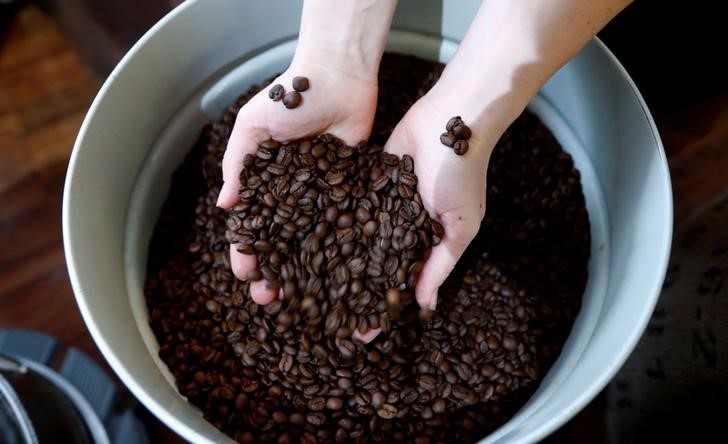 © Reuters. Coffee’s Gloomy Days May Soon Be Over as Rout Hurts Producers
© Reuters. Coffee’s Gloomy Days May Soon Be Over as Rout Hurts Producers(Bloomberg) — Gloom and doom have gripped the coffee market for months. But as executives and traders gathered for one of the biggest industry events of the year, a cautious optimism was in the air.
Prices have gotten so low that pretty soon they’re going to force some producers to cut back on crop investments, eventually helping to trim output, Kona Haque, the head of research at London-based trader ED&F Man Holdings Ltd., said in an interview during the National Coffee Association annual conference. Growers with higher costs, like those in Central America, will probably be the first to respond, she said.
Haque’s view was echoed over and over again at the conference that was held in New Orleans March 15-18. The meeting drew about 700 participants including representatives from coffee roasters, trade houses, importers, producers and brokers. Most attendees agreed that an 18 percent drop for arabica futures over the past year means that the market’s bearish factors have already been priced in as they expressed hope that a bottom was in sight.
Other highlights from the conference:
Brazil’s Crop
Brazil’s massive production has been one of the drivers for the coffee rout. The good news for bulls: the harvest may not be quite as huge as expected. A survey during the conference showed that traders and analysts expect a crop of 57.8 million bags, according to the average outlook of nine respondents. In January, the nation’s forecasting agency said output could climb as much as 30 percent to a record 58.5 million bags. A bag weighs 60 kilograms, or 132 pounds.
Rival Producers
As Brazil’s large crop weighs on prices, producers in other nations are under threat.
Roberto Velez, chief executive officer of Colombia’s National Federation of Coffee Growers, expressed “deep concern” about the future of production in his country. Accounting for inflation, local prices have dropped about 0.7 percent on an annual basis for the past few decades and are now at similar levels as seen in 1983, he said in an interview during the conference.
A similar scenario is emerging in Honduras, said Basilio Fuschich, general manager at Compania Hondurena del Cafe, the country’s top exporter. Brazil is the world’s top grower of arabica beans, followed by Colombia and Honduras.
Higher Volatility
Speculators are holding a near-record wager on falling arabica prices, U.S. government data show. The large position leaves the market vulnerable to bouts of higher volatility, especially given the outlook for supplies to be relatively balanced with demand, Julio Sera, risk management consultant for INTL FCStone, said in an interview at the conference. Developments in the Brazilian harvest are likely to drive swings in the coming months, he said.
U.S. Consumption
The number of Americans drinking coffee on a daily basis advanced to 64 percent in 2018, according to an annual survey from the New York-based National Coffee Association. That compares with 62 percent last year. Coffee remained the favorite beverage, topping bottled water, soft drinks and tea.
Fusion Media or anyone involved with Fusion Media will not accept any liability for loss or damage as a result of reliance on the information including data, quotes, charts and buy/sell signals contained within this website. Please be fully informed regarding the risks and costs associated with trading the financial markets, it is one of the riskiest investment forms possible.
Source: Investing.com






























